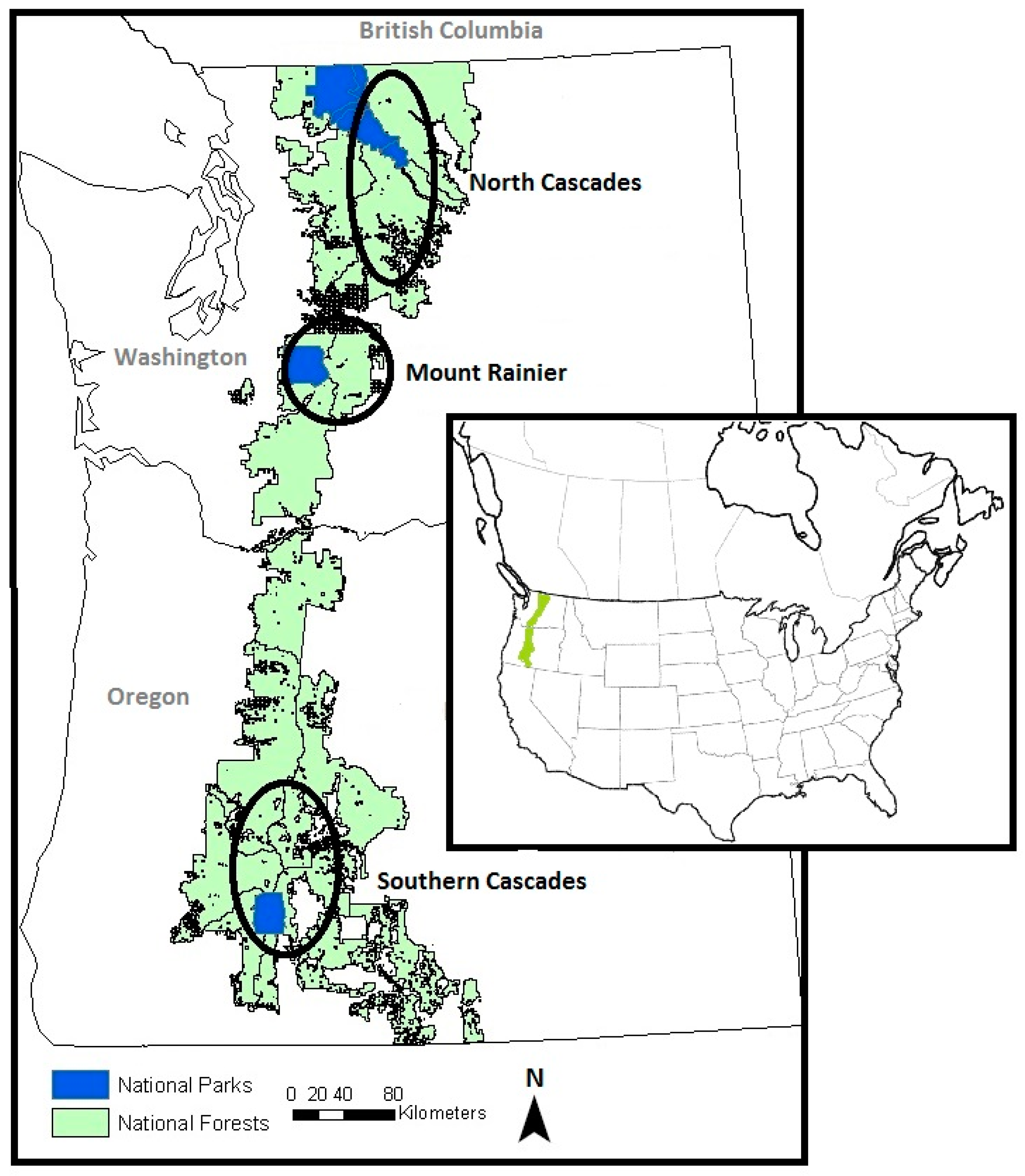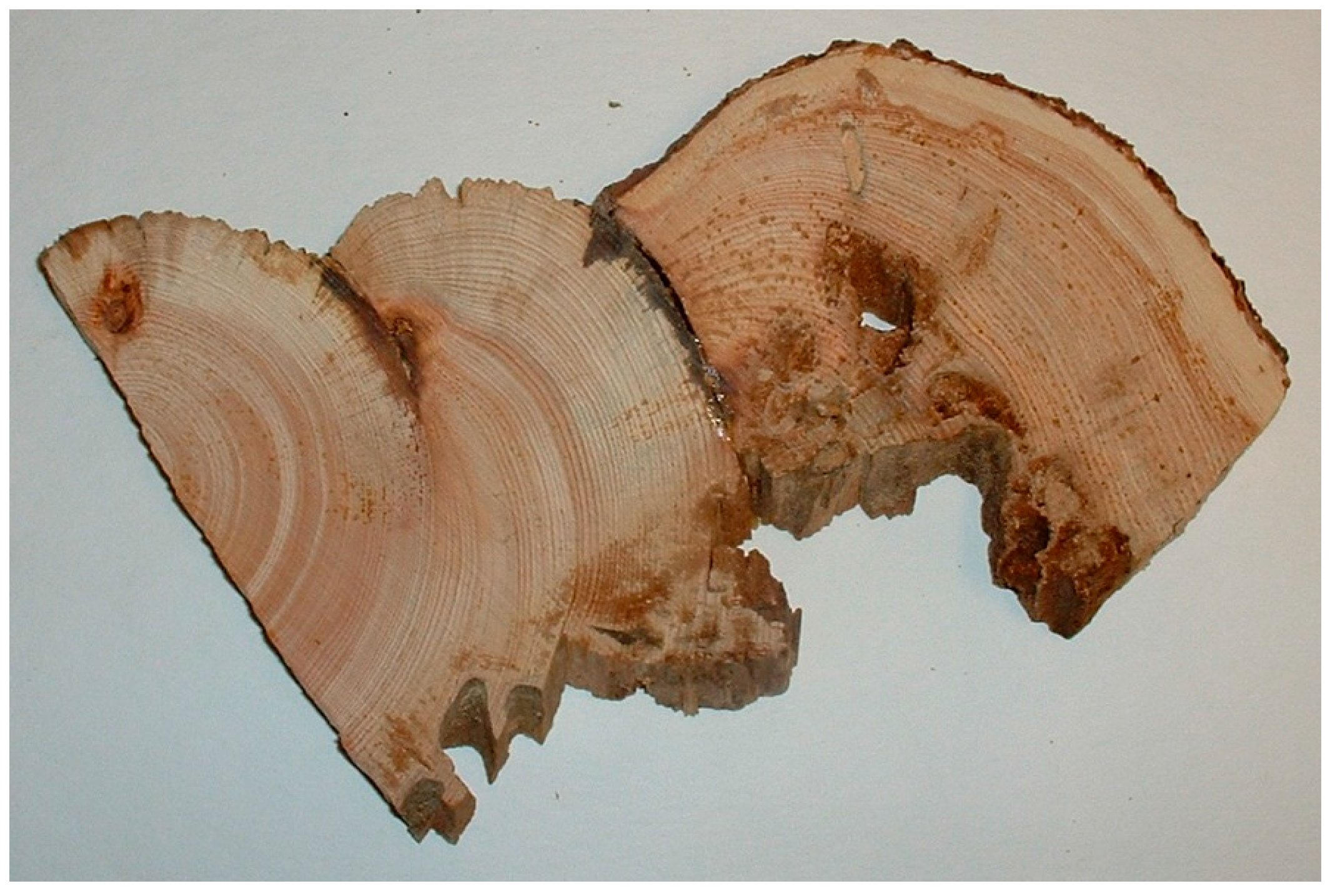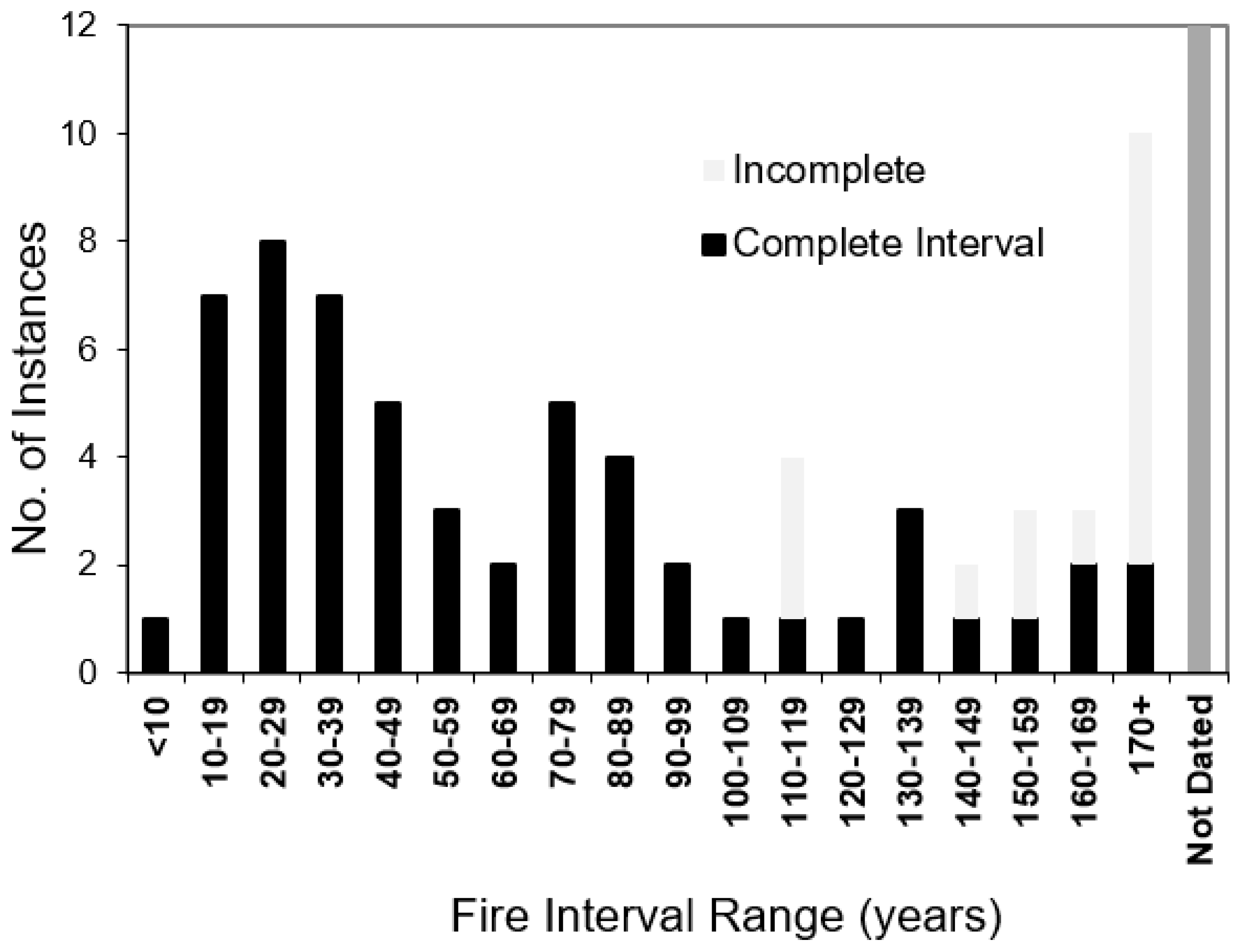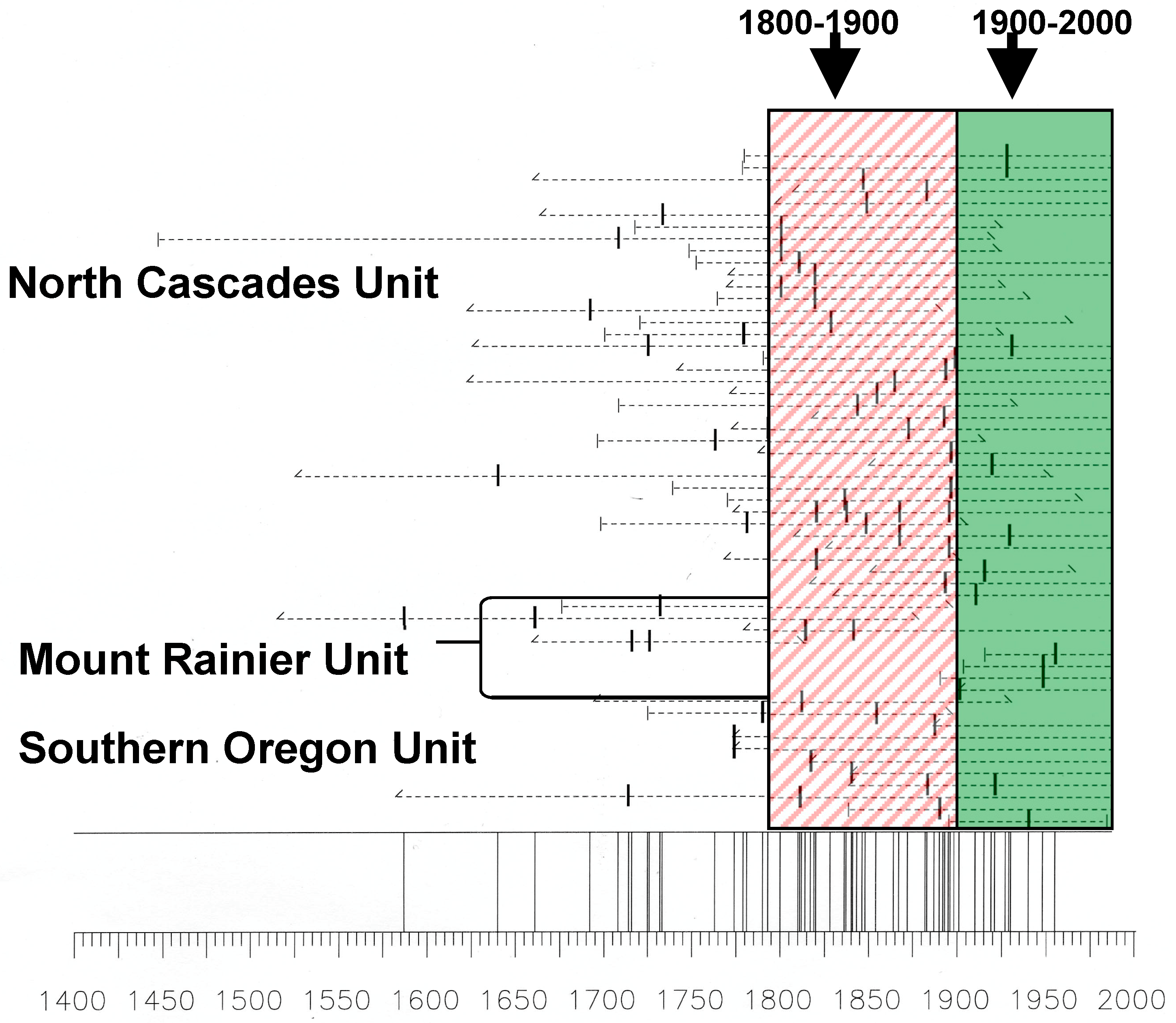Historic Frequency and Severity of Fire in Whitebark Pine Forests of the Cascade Mountain Range, USA
Abstract
:1. Introduction
2. Materials and Methods
3. Results
4. Discussion
5. Conclusions
Supplementary Materials
Supplementary File 1Acknowledgments
Author Contributions
Conflicts of Interest
References
- Ellison, A.M.; Bank, M.S.; Clinton, B.D.; Colburn, E.A.; Elliott, K.; Ford, C.R.; Foster, D.R.; Kloeppel, B.D.; Knoepp, J.D.; Lovett, G.M.; et al. Loss of foundation species: Consequences for the structure and dynamics of forested ecosystems. Front. Ecol. Environ. 2005, 3, 479–486. [Google Scholar] [CrossRef]
- Tomback, D.F.; Arno, S.F.; Keane, R.E. Whitebark Pine Communities: Ecology and Restoration; Island Press: Washington, DC, USA, 2001; p. 440. [Google Scholar]
- Schwandt, J.W.; Lockman, I.B.; Kliejunas, J.T.; Muir, J.A. Current health issues and management strategies for white pines in the western United States and Canada. For. Pathol. 2010, 40, 226–250. [Google Scholar] [CrossRef]
- U.S. Department of the Interior, Fish and Wildlife Service (USFWS). Endangered and threatened wildlife and plants; review of native species that are candidates for listing as endangered or threatened; annual notice of findings on resubmitted petitions; annual description of progress on listing actions. In Fed. Regist.; 2015; 80, pp. 80584–80612. [Google Scholar]
- Environment Canada. Order Amending Schedule 1 to the Species at Risk Act; Canada Gazette Part II, No. 14, SOR/2012-113; Environment Canada: Toronto, ON, Canada, 2012; 146.
- United States Department of Agriculture (USDA) Forest Service. Fire Effects Information System (FEIS): Syntheses about Fire Ecology and Fire Regimes in the United States. 2018. Available online: https://www.feis-crs.org/feis/ (accessed on 9 January 2018).
- Keane, R.E.; Arno, S.F. Rapid decline of whitebark pine in western Montana: Evidence from 20-year re-measurements. West. J. Appl. For. 1993, 8, 44–47. [Google Scholar]
- Murray, M.P.; Bunting, S.C.; Morgan, P.C. Landscape trends (1753–1993) of whitebark pine (Pinus albicaulis) forests in the West Big Hole Range, Idaho/Montana, USA. Arct. Antarct. Alp. Res. 2000, 32, 412–418. [Google Scholar] [CrossRef]
- Tomback, D.F. Post-fire regeneration of krummolz whitebark pine: A consequence of nutcracker seed caching. Madroῆo 1986, 33, 100–110. [Google Scholar]
- Keane, R.E.; Parsons, R.A. Restoring whitebark pine forests of the northern Rocky Mountains, USA. Ecol. Restor. 2010, 20, 56–70. [Google Scholar] [CrossRef]
- Van Mantgem, P.J.; Nesmith, J.C.B.; Keifer, M.; Knapp, E.E.; Flint, A.; Flint, L. Climatic stress increases forest fire severity across the western United States. Ecol. Lett. 2013, 16, 1151–1156. [Google Scholar] [CrossRef] [PubMed]
- Schellhaas, R.; Spurbeck, D.; Ohlson, P.; Keenum, D.; Riesterer, H. Fire Disturbance Effects in Subalpine Forests of North Central Washington. In USDA Forest Service—Region 6. Report on File at Wenatchee Forest Sciences Laboratory; USDA Forest Service: Washington, DC, USA, 2001. [Google Scholar]
- Agee, J.K. Fire Ecology of Pacific Northwest Forests; Island Press: Washington, DC, USA, 1993. [Google Scholar]
- Arno, S.F. The Historical Role of Fire on the Bitterroot National Forest; Research Paper INT-187; U.S. Department of Agriculture, Forest Service, Intermountain Forest and Range Experiment Station: Ogden, UT, USA, 1976.
- Morgan, P.; Bunting, S.C. Fire Effects in Whitebark Pine Forests. In Proceedings of the Symposium on Whitebark Pine Ecosystems: Ecology and Management of a High-Mountain Resource, Bozeman, MT, USA, 29–31 March 1989; Schmidt, W.C., McDonald, K.J., Eds.; General Technical Report INT-270. U.S. Department of Agriculture, Forest Service, Intermountain Forest and Range Experiment Station: Ogden, UT, USA, 1990. [Google Scholar]
- Barrett, S.W. Fire regimes on andesitic mountain terrain in northeastern Yellowstone National Park, Wyoming. Int. J. Wildland Fire 1994, 4, 64–76. [Google Scholar] [CrossRef]
- Murray, M.P. Landscape Dynamics of an Island Range: Interrelationships of Fire and Whitebark Pine (Pinus albicaulis). Ph.D. Thesis, University of Idaho, Moscow, ID, USA, 1996. [Google Scholar]
- Renkin, R.A.; Despain, D.G. Fuel moisture, forest type, and lightning-caused fire in Yellowstone National Park. Can. J. For. Res. 1992, 22, 37–45. [Google Scholar] [CrossRef]
- Brown, J.K.; Arno, S.F.; Barrett, S.W.; Menakis, J.P. Comparing the prescribed natural fire program with pre-settlement fires in the Selway-Bitterroot Wilderness. Int. J. Wildland Fire 1994, 4, 157–168. [Google Scholar] [CrossRef]
- Arno, S.F.; Sneck, K.M. A Method for Determining Fire History in Coniferous Forests of the Mountain West; General Technical Report INT-42; U.S. Department of Agriculture, Forest Service, Intermountain Forest and Range Experiment Station: Ogden, UT, USA, 1977.
- Barrett, S.W.; Arno, S.F. Increment-Borer Methods for Determining Fire History in Coniferous Forests; General Technical Report INT-244; U.S. Department of Agriculture, Forest Service, Intermountain Forest and Range Experiment Station: Ogden, UT, USA, 1988.
- Gutsell, S.L.; Johnson, E.A. How fire scars are formed: A coupling a disturbance process to its ecological effect. Can. J. For. Res. 1996, 26, 166–174. [Google Scholar] [CrossRef]
- Heyerdahl, E.K.; McKay, S.J. Condition of live fire-scarred ponderosa pine twenty-one years after removing partial cross-sections. Tree-Ring Res. 2017, 73, 149–153. [Google Scholar] [CrossRef]
- Lorimer, C.G. Methodological considerations in the analysis of forest disturbance history. Can. J. For. Res. 1984, 15, 200–213. [Google Scholar] [CrossRef]
- Keith, R.P.; Veglen, T.T.; Schoennagel, T.L.; Sherriff, R.L. Understory vegetation indicates historic fire regimes in ponderosa pine-dominated ecosystems in the Colorado Front Range. J. Veg. Sci. 2010, 21, 488–499. [Google Scholar] [CrossRef]
- Murray, M.P.; Bunting, S.C.; Morgan, P.C. Fire history of an isolated subalpine mountain range of the Intermountain Region, United States. J. Biogeogr. 1998, 25, 1071–1080. [Google Scholar] [CrossRef]
- Applequist, M.B. A simple pith locator for use with off-center increment cores. J. For. 1958, 56, 141. [Google Scholar]
- Villalba, R.; Veblen, T.T. Improving estimates of total tree ages based on increment core samples. Ecoscience 1997, 4, 534–542. [Google Scholar] [CrossRef]
- Stokes, M.A.; Smiley, T.L. An Introduction to Tree-Ring Dating; University of Chicago Press: Chicago, IL, USA; London, UK, 1968. [Google Scholar]
- Yamaguchi, D.K. A simple method for cross-dating increment cores from living trees. Can. J. For. Res. 1991, 21, 414–416. [Google Scholar] [CrossRef]
- Grissino-Mayer, H.D. Evaluating crossdating accuracy: A manual and tutorial for the computer program cofecha. Tree-Ring Res. 2001, 57, 205–221. [Google Scholar]
- Brubaker, L.B. Sunrise Ridge: PIAL-ITRDB WA040. National Centers for Environmental Information, NESDIS, NOAA, U.S. Department of Commerce: Boulder, CO, USA, 1976. Available online: https://www.ncdc.noaa.gov/data-access/paleoclimatology-data (accessed on 5 February 2018).
- Peterson, D.W. Dendroecological Study of Subalpine Conifer Growth in the North Cascade Mountains. Master’s Thesis, University of Washington, Seattle, WA, USA, 1993. [Google Scholar]
- Walsh, J.R. Fire Regimes and Stand Dynamics of Whitebark Pine (Pinus albicaulis) Communities in the Greater Yellowstone Ecosystem. Master’s Thesis, Colorado State University, Fort Collins, CO, USA, 2005. [Google Scholar]
- Alexander, M.E. Estimating Fuel Weights of Two Common Shrubs in Colorado Lodgepole Pine Stands; Research Note RM-354; U.S. Department of Agriculture, Forest Service, Rocky Mountain Forest and Range Experiment Station: Fort Collins, CO, USA, 1978; p. 4.
- Rorig, M.; Ferguson, S.A. Characteristics of lightning and wildland fire ignition in the Pacific Northwest. J. Appl. Meteorol. 1999, 38, 1565–1575. [Google Scholar] [CrossRef]
- Gedalof, Z.; Smith, D.J. Interdecadal climate variability and regime scale shifts in Pacific North America. Geophys. Res. Lett. 2001, 28, 1515–1518. [Google Scholar] [CrossRef]
- Keane, R.E.; Tomback, D.F.; Aubry, C.A.; Bower, A.D.; Campbell, E.M.; Cripps, C.L.; Jenkins, M.B.; Mahalovich, M.F.; Manning, M.; McKinney, S.T.; et al. A Range-Wide Restoration Strategy for Whitebark Pine (Pinus albicaulis); General Technical Report RMRS-GTR-279; U.S. Department of Agriculture, Forest Service, Rocky Mountain Research Station: Fort Collins, CO, USA, 2012; p. 108.
- Keane, R.E.; Quinn, D.; Cochrane, J. Guidelines and Best Practices for Managing Fire in Whitebark Pine Stands in the Crown of the Continent; US Forest Service Rocky Mountain Research Station, Missoula Fire Sciences Laboratory: Missoula, MT, USA, 2017; p. 25.
- Perkins, D.L.; Means, R.E.; Cochrane, A.C. Conservation and Management of Whitebark Pine Ecosystems on Bureau of Land Management Lands in the Western United States; Technical Reference 6711-1; Bureau of Land Management: Denver, CO, USA, 2016; p. 93.




| Study Unit | Number of Plots | Plots with Charcoal | Plots with Charcoal |
|---|---|---|---|
| Southern Oregon | 28 | 23 | 82% |
| Mount Rainier | 15 | 13 | 87% |
| North Cascades | 18 | 18 | 100% |
| Total | 61 | 54 | 89% |
| Number of Sites | Total | |
|---|---|---|
| No Fire Dates | 12 | 22% |
| Single Fire Date | 15 | 27% |
| Two or more Fire Dates | 28 | 51% |
| Total | 55 | 100% |
| Dominant Overstory Vegetation | No. of Sites | No. of Intervals | MSAFI 1 with Range (Years) | Median (Years) | Standard Deviation (Years) | Severity (No. Fires Low/High) |
|---|---|---|---|---|---|---|
| Whitebark Pine/Douglas-fir | 2 | 10 | 47 (11–161) | 31 | 46 | 12/3 |
| Whitebark Pine/Subalpine Fir or Shasta Red Fir | 22 | 30 | 67 (11–64) | 64 | 43 | 19/25 |
| Whitebark Pine/Engelmann Spruce | 3 | 3 | 72 (9–196) | 10 | 108 | 3/2 |
| Whitebark Pine/Lodgepole Pine | 8 | 13 | 73 (12–314) | 54 | 79 | 14/8 |
| Whitebark Pine (Pure Stands) | 10 | 3 | 96 (38–153) | 97 | 58 | 5/5 |
| Whitebark Pine/Mountain Hemlock | 10 | 0 | >250 years | - | - | 0/5 |
| All Sites | 55 | 59 | 67 (9–196) | 49 | 57 | 53/48 |
| Dominant Understory Vegetation | No. of Sites | No. of Intervals | MSAFI 1 with Range (Years) | Median (Years) | Standard Deviation (Years) | Severity (No. Fires Low/High) |
|---|---|---|---|---|---|---|
| Pinegrass (Calamagrostis rubescens) | 3 | 9 | 44 (11–134) | 34 | 39 | 8/4 |
| Grouse Whortleberry (Vaccinium scoparium) | 20 | 25 | 55 (9–196) | 49 | 48 | 19/22 |
| Common Juniper (Juniperus communis) | 3 | 5 | 64 (33–140) | 48 | 44 | 3/5 |
| Greenleaf Fescue (Festuca viridula Vasey) | 5 | 9 | 84 (11–164) | 64 | 57 | 8/5 |
| Dryland Grass 2 | 12 | 10 | 93 (13–120) | 65 | 86 | 11/8 |
| Pinemat Manzanita (Arctostaphylos nevadensis) | 4 | 1 | 130 | 130 | - | 2/2 |
| Sparse Vegetation | 8 | 0 | >250 years | - | - | 0/4 |
| Study Unit | High Severity | Low Severity |
|---|---|---|
| Southern Oregon | 10 (56%) | 8 (44%) |
| Mount Rainier | 6 (75%) | 2 (25%) |
| North Cascades | 8 (47%) | 9 (53%) |
| Totals | 24 (56%) | 19 (44%) |
© 2018 by the authors. Licensee MDPI, Basel, Switzerland. This article is an open access article distributed under the terms and conditions of the Creative Commons Attribution (CC BY) license (http://creativecommons.org/licenses/by/4.0/).
Share and Cite
Murray, M.P.; Siderius, J. Historic Frequency and Severity of Fire in Whitebark Pine Forests of the Cascade Mountain Range, USA. Forests 2018, 9, 78. https://doi.org/10.3390/f9020078
Murray MP, Siderius J. Historic Frequency and Severity of Fire in Whitebark Pine Forests of the Cascade Mountain Range, USA. Forests. 2018; 9(2):78. https://doi.org/10.3390/f9020078
Chicago/Turabian StyleMurray, Michael P., and Joel Siderius. 2018. "Historic Frequency and Severity of Fire in Whitebark Pine Forests of the Cascade Mountain Range, USA" Forests 9, no. 2: 78. https://doi.org/10.3390/f9020078





